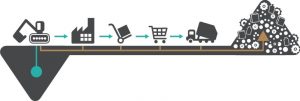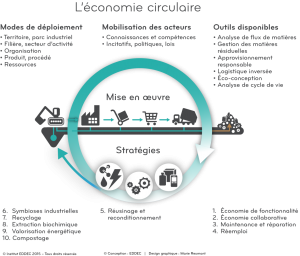
This collective work published by the Institut de l’environnement, du développement durable et de l’économie circulaire (Institut EDDEC – Environment, Sustainable Development and Circular Economy Institute) presents the views of some 50 experts on the circular economy model and is offered free of charge in order to advance this evolving concept. The opinions expressed in the book are united by a common goal to convincingly demonstrate to the reader that the transition from the traditional linear economy to a new circular economy model is crucial and inevitable. The diagrams of the two types of economy show the losses that a strictly linear economy suffers at every step of its value chain.


Source: Institut EDDEC http://instituteddec.org/themes/economie-circulaire/#1478637474475-2c0d9976-6af5
The context statement grabs our attention right away: “It is estimated that every year the world’s population consumes more renewable resources than the planet can generate”. Don’t be taken aback by the numerous concepts – collaborative economy, circular economy, economy by sharing, industrial symbiosis, etc. – as the definitions are still evolving, and there is yet no global consensus at this time. The key objective is to review and rethink the ways we currently function as consumers, companies and society in order to create value for everyone in a sustainable way.
According to the Institut EDDEC, the circular economy is “a system of production, exchange and consumption aiming to optimize the use of resources at every stage of the lifecycle of goods or services, by reducing the environmental footprint and contributing to the wellbeing of individuals and communities”.
Inspiring Examples
What could be the benefits for your business?
There are many challenges to a successful implementation of the circular economy model on a global or even regional scale (starting with the engagement of all the parties involved). However, just the reflection can become a reality check for companies and help them re-examine their operations. To begin, let’s look at your organization as a system where each step has a potential for optimization in order to cut down emissions and to boost added value. Can this system be expanded from the supplier to the consumer? Are there companies near you that could use your by-products as their raw materials and vice versa?
Authors: Under the direction of Sébastien Sauvé, Daniel Normandin and Mélanie McDonald
By Marie-Josée Roy, Eng., M.Env.
Expert in Strategic Management, Performance and Durability
Totem Performance organisationnelle